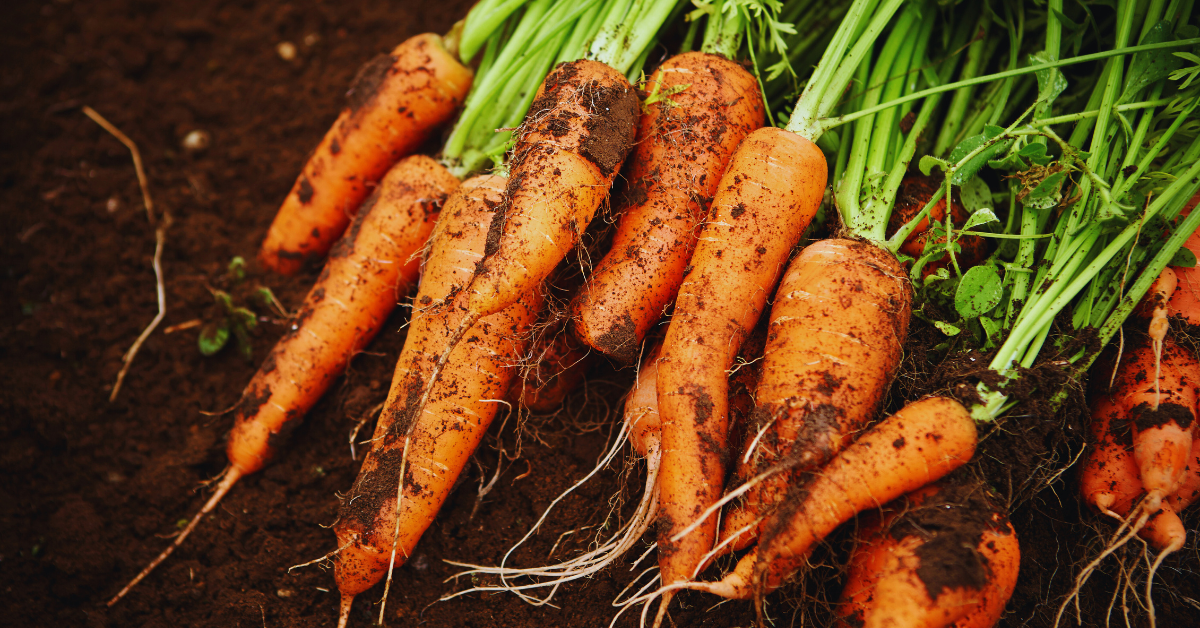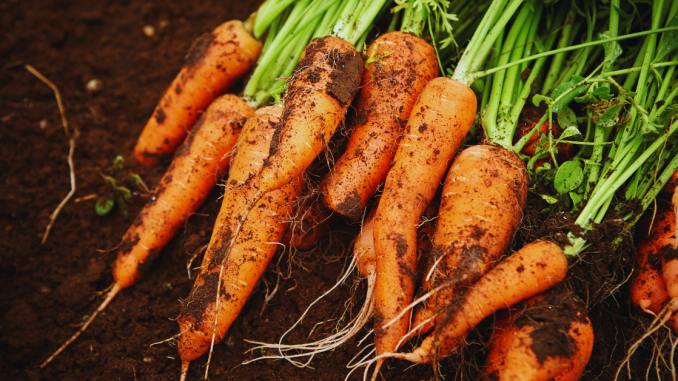

Imagine eating 100 carrots and getting the same nutrition as a single carrot from your grandparents’ era. That’s not science fiction—it’s happening right now. Even your perfect diet, packed with superfoods and lean proteins, could be secretly starving you. Over the last 70 years, our food has lost up to 99% of its vital nutrients. Today, I’m going to reveal 4 critical nutrients that are disappearing from your food, why it’s happening, and—most importantly—how you can fix it. Stick around, because this information could completely transform your health.
Let’s start with the root of the problem: the soil.
The food we eat is only as nutritious as the soil it grows in. For thousands of years, plants absorbed minerals and nutrients from the earth, and when we ate those plants—or the animals that ate those plants—we got all the vitamins and minerals we needed to thrive.
In the 1960s, a dramatic shift occurred in our food system. As giant agricultural corporations began buying family farms, they introduced intensive farming methods that prioritized quantity over quality. Instead of letting the soil rest and replenish, farmers planted the same crops repeatedly, year after year. They also used chemical fertilizers and herbicides, which made plants grow bigger and faster but stripped the soil of its natural nutrients, leading to nutrient-poor plants and less nutrition for us.
The impact on our food has been staggering. One Australian study showed that between 1948 and 1991, apples lost 80% of their vitamin C, meaning you’d need to eat five apples today to get the same amount of vitamin C as one apple from 1948. Carrots have lost 99% of their beta-carotene, which your body converts to vitamin A, so you’d need to eat 100 carrots today to get the same amount of beta-carotene as one carrot from the 1940s.
This nutrient depletion extends beyond our produce to affect our protein sources as well. The shift from traditional grass-feeding to modern grain-feeding practices has significantly altered beef’s nutritional profile. Grass-fed beef contains up to 2-3 times more B vitamins, and 5-6 times more omega-3 fatty acids than grain-fed cattle raised in factory farms.
The consequences of these nutrient losses affect us directly—these vitamins and minerals are the building blocks of a healthy body, and without them, we’re left feeling sluggish, weak, and prone to illness.
At this point, you’re probably wondering about solutions. You might be thinking, ‘I’ll just take a multivitamin and call it a day,’ but here’s the thing: multivitamins are like trying to fight a wildfire with a squirt gun. Sure, they provide a dose of vitamins, but your body might not absorb them effectively.
Think of your body as a car and vitamins as fuel. If the engine is broken, no amount of fuel will make it run. That’s why just taking a multivitamin isn’t enough—you need to fix the engine, or in this case, address the missing nutrients.
So, what exactly is this ‘engine’ that needs fixing? It turns out there are four critical nutrients that act like the spark plugs, oil, and filters of your body’s engine. These are the missing pieces that make everything else work better.
Let’s start with the most important nutrient: fulvic acid—your body’s master key and one of the most powerful nutrients you’ve never heard of.
This organic compound, created by beneficial soil microorganisms during plant decomposition, doesn’t just carry over 70 trace minerals and antioxidants—it’s your body’s ultimate nutrient booster.
Without fulvic acid, it’s like having premium fuel but no spark plugs; your body can’t utilize the vitamins and minerals you consume. It’s nature’s delivery system, ushering nutrients in and escorting toxins out, while firing up your energy and supercharging your digestion.
Unfortunately, modern pesticides and chemical fertilizers have killed off the microorganisms that create fulvic acid, leading to a crisis. These chemicals disrupt its natural formation in humus—that rich, dark organic matter in soil created when plants decompose.
Your body needs 100 to 500 mg of fulvic acid daily, but even organic root vegetables can’t provide enough anymore. Those wild mushrooms, blackstrap molasses, and root vegetables that once burst with fulvic acid? They’re now nearly empty.
There are only two places where fulvic acid still exists in abundance:
One: Shilajit, a rare, tar-like substance that oozes from Himalayan rocks, concentrated by centuries of pressure. But even this natural wonder contains only 15 to 20% fulvic acid.
Two: MLG-50, a fulvic mineral complex produced from a unique deposit in the Southern United States, delivers 35% fulvic acid—almost double what’s found in shilajit. It’s like centuries of nature’s work in a single dose.
Now that we’ve unlocked your body’s ability to absorb nutrients with fulvic acid, let’s talk about protecting them.
Enter our second nutrient, astaxanthin—nature’s strongest antioxidant.
That vibrant pink in wild salmon? That’s astaxanthin, a compound that helps fuel their incredible upstream journeys.
This remarkable nutrient slashes muscle soreness by 58% after workouts, helps you bounce back faster, and even protects your eyes from digital strain—with half of study participants reporting complete relief in just four weeks. Studies show it’s significantly stronger than vitamin C at protecting cell membranes.
To achieve these benefits, research shows your body needs 4 to 8 mg of astaxanthin daily. In nature, wild salmon obtain astaxanthin by consuming tiny sea creatures that feed on microscopic algae. These algae are nature’s richest source of astaxanthin, giving wild salmon their pink color and nutritional benefits.
But farmed salmon tell a different story. Without synthetic astaxanthin added to their feed, their flesh would be gray. The farming industry uses synthetic astaxanthin primarily as a coloring agent to achieve the pink color consumers expect. The problem? This synthetic version is 20 to 30 times weaker in nutritional benefits than natural astaxanthin. Wild sockeye salmon contains roughly four to five times more astaxanthin than farmed salmon. Plus, it’s in its natural, more bioavailable form.
This difference creates a modern dilemma: to get just the minimum effective dose, you’d need to eat 4 ounces of wild sockeye salmon every single day. Getting enough natural astaxanthin from food today is nearly impossible.
Now that we’ve covered how astaxanthin protects your muscles and eyes, let’s move to another critical protector—this time for your bones.
Enter our third nutrient, tocotrienols, remarkable members of the vitamin E family that are revolutionizing bone health.
Studies show these compounds significantly improve bone strength, prevent osteoporosis, and accelerate fracture healing. Unlike regular vitamin E, tocotrienols penetrate cell membranes more effectively, fighting the oxidative stress and inflammation that lead to bone loss as we age.
Your body needs 200 to 300 mg of tocotrienols daily for therapeutic effects, but the average American gets only 2 to 3 mg—far below optimal levels.
Why? The richest sources, like palm oil and rice bran oil, are rarely used in Western diets, and modern food processing strips away these valuable compounds from the foods we do eat.
Nature packs tocotrienols primarily in palm oil, which contains up to 70% of its vitamin E as tocotrienols. But to reach optimal levels, you’d need to consume an entire cup of palm oil (100-200 g) or 1.5 to 4 kg of wheat germ daily—amounts that are impractical.
The real breakthrough comes from combining these nutrients. When paired with astaxanthin, tocotrienols create a synergistic antioxidant effect, and combined with fulvic acid, they form a powerful support system for bone health.
Now that we’ve covered three powerful protectors—from muscles to eyes to bones—let’s complete our nutrient quartet with your body’s energy producer: CoQ10 (Coenzyme Q10).
Think of it as your cellular battery pack, working alongside fulvic acid to power every cell in your body.
Found in every cell, CoQ10 is essential for heart health, brain function, and energy production. Your body needs 100 to 200 mg of CoQ10 daily, but natural food sources provide surprisingly small amounts. Even organ meats—the richest source—contain only small amounts of CoQ10. Fatty fish like mackerel provide even less, and vegetables like broccoli offer only trace amounts. When combined with fulvic acid, however, studies show CoQ10 can increase energy production by 144% in muscle cells and 56% in the brain.
But like the other nutrients we’ve discussed, CoQ10 faces a double crisis. First, our bodies’ natural production peaks in our 20s and steadily declines—by age 65, we have less than half the CoQ10 we had at 25. Second, modern food processing has stripped away much of the CoQ10 from our food sources. Our typical diet provides just 25% of what we need, and this shortfall grows as we age.
This is where fulvic acid’s role becomes crucial again—it helps shuttle CoQ10 directly into your mitochondria, your cells’ power plants, where it’s needed most. These tiny energy factories convert nutrients into fuel, and with fulvic acid, CoQ10 makes this process far more efficient.
There you have it: four critical nutrients that modern farming and food processing have stripped from our food supply. While our produce may look the same on the outside, it contains just a fraction of its original nutritional power—making it virtually impossible to get therapeutic amounts from diet alone.
You could purchase these supplements individually, but that means managing multiple pills, significant expense, and the challenge of finding quality sources. To solve this, researchers combined these four powerful nutrients into one scientifically-formulated blend:
MLG-50’s concentrated fulvic mineral powder with 35% pure fulvic acid
Natural astaxanthin from Hawaiian microalgae
Tocotrienols from Malaysian palm oil
High-potency CoQ10 from Japan
The formula harnesses fulvic acid’s ability to enhance nutrient absorption, creating powerful synergistic effects. Clinical studies show remarkable results after just four weeks: 96% reported increased energy, 87% experienced stronger muscles, and 96% improved digestion.
Each ingredient is carefully selected and precisely combined to deliver optimal therapeutic doses of these essential nutrients that modern diets simply can’t provide. To discover how this breakthrough formula can transform your health,
.png)









 English (US)
English (US)